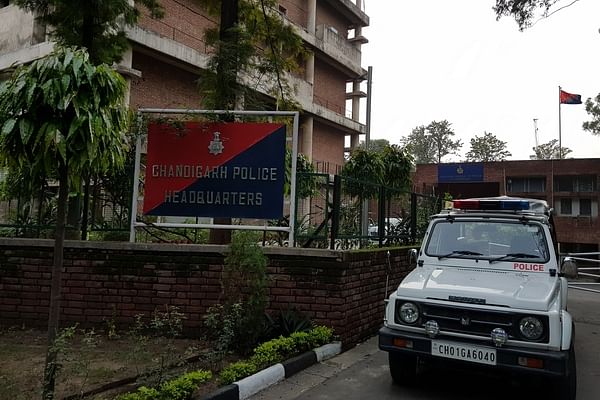With officers drawn from three cadres running the union territory, administration and law enforcement of Chandigarh is often uncoordinated, haphazard and messy.
The investigation of the Chandigarh stalking case involving the son of the Haryana BJP chief has not only raised questions about how the police has handled the crime but also brought into focus the chaotic organisation and working of the bureaucracy and law enforcement agencies of the union territory.
Who does the Chandigarh Police report to? The city is headed by an administrator, who is a political appointee of the ruling party at the Centre. His secretary is a Punjab cadre IAS officer but his adviser is an AGMUT (Arunachal Pradesh Goa, Mizoram and Union Territories) cadre officer.
Similarly, the police force is headed by an AGMUT IPS officer but the home secretary, heading the police administration, is a Haryana cadre IAS officer. The senior superintendent of police (SSP) Chandigarh is, however, a Punjab IPS officer.
Chandigarh, by way of its unique position of being a UT as well as the common capital of Punjab and Haryana, is a melting pot of sorts for officers from different states and services. Ideally, such an administrative system should have been immune to institutional pressures. But over the years, it has led to uncoordinated, haphazard individualistic efforts at governance with the malaise most visible in the working of the police.
Chandigarh was Punjab’s capital from 1952 to 1966 and a ‘chief commissioner’ was in charge of the town. In 1966, when Haryana was carved out of Punjab, both states staked claim to Chandigarh as capital, a contention which continues. However, the Centre declared Chandigarh a UT and its administration came directly under the union home ministry.
In 1984, when militancy peaked in Punjab, the situation required better coordination between the state and the Centre and Punjab’s governor was made Chandigarh’s administrator. The chief commissioner’s post was re-designated as ‘adviser to the administrator’. This system has continued since.
The adviser to the administrator is a senior AGMUT cadre officer, in-charge of Chandigarh. The home secretary (HS), the next in the chain of command, is an IAS officer of Haryana and the finance secretary (FS) is always an IAS officer from Punjab. The three positions are demanding, with the HS and FS also burdened with the responsibility of over a dozen other departments.
If the city is lucky, then these three bureaucrats work in harmony, but it rarely happens. They are generally at loggerheads and cadre wars are common. A former adviser, Vijay Kumar Dev, was criticised for creating a coterie of AGMUT officers under him. His predecessor, K.K. Sharma, virtually divested the then home secretary Anil Kumar of his powers, handing them to AGMUT officers.
AGMUT cadre officers are seen as “encroachers”. According to MHA guidelines, the city is to draw officers, teachers, doctors, engineers etc., from Punjab and Haryana in the ratio of 60:40. Both states rue the gradual dilution of these instructions with AGMUT officers coming in.
Both Punjab and Haryana see this as an attempt by the Centre to tighten its grip on the city through its officers. In 2014, the then Haryana CM Bhupinder Singh Hooda asked the MHA to rotate the post of the adviser between Punjab and Haryana and that no AGMUT officer should be posted. Previous CM Parkash Singh Badal had also demanded that a 60:40 ratio be maintained among officers.
The administrative and operational problems due to this mismatch of officers are more visible in the police. The top position was that of an SSP until 1981, when the post of an IG was created and in 2010 a DIG’s post was added, both filled from AGMUT. Currently, the IG’s post is held by ADGP Tejender Singh Luthra.
The SSP (law and order) is always a Punjab officer and the city will get its first woman SSP soon when J. Nilambri, a 2008 cadre officer, takes charge. The next important position in Chandigarh police is that of SSP traffic, currently held by Shashank Anand, a 2006 batch Haryana IPS officer and son-in-law of former Haryana DGP Ranjiv Dalal. The fact that he is senior to Nilambri causes an administrative anomaly difficult to ignore.
Three other SP level officers, next in line, are from AGMUT cadre.
Under these officers are almost two dozen DSPs and a constant battle is on among officers drawn from DANIPS (NCT of Delhi, Andaman & Nicobar Islands, Lakshadweep, Daman & Diu and Dadra & Nagar Haveli Police Service), Punjab, Haryana and the those promoted from the lower ranks.
Inspector-level local officers are dead against DSP positions being filled from other states/services as it takes away their promotion avenues. Besides the ongoing protracted litigation among DSPs, the rivalry hampers investigations, with each wanting the other to fail.
Local DSPs would have watched with delight when DSP (east) Ashish Kumar, a DANIPS officer — and the second son-in-law of Ranjiv Dalal — got brickbats for his handling of the stalking case.



